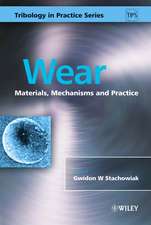Theoretical and Computational Aerodynamics: Aerospace Series
Autor TK Senguptaen Limba Engleză Hardback – 13 noi 2014
Din seria Aerospace Series
- 5%
 Preț: 512.54 lei
Preț: 512.54 lei - 24%
 Preț: 724.91 lei
Preț: 724.91 lei - 18%
 Preț: 935.27 lei
Preț: 935.27 lei - 24%
 Preț: 630.69 lei
Preț: 630.69 lei - 20%
 Preț: 440.40 lei
Preț: 440.40 lei - 24%
 Preț: 652.63 lei
Preț: 652.63 lei - 11%
 Preț: 593.41 lei
Preț: 593.41 lei - 24%
 Preț: 545.45 lei
Preț: 545.45 lei - 24%
 Preț: 631.10 lei
Preț: 631.10 lei - 24%
 Preț: 688.22 lei
Preț: 688.22 lei - 14%
 Preț: 704.57 lei
Preț: 704.57 lei - 20%
 Preț: 536.77 lei
Preț: 536.77 lei - 24%
 Preț: 560.70 lei
Preț: 560.70 lei - 24%
 Preț: 522.32 lei
Preț: 522.32 lei - 19%
 Preț: 522.86 lei
Preț: 522.86 lei - 24%
 Preț: 626.73 lei
Preț: 626.73 lei - 20%
 Preț: 402.13 lei
Preț: 402.13 lei - 23%
 Preț: 593.66 lei
Preț: 593.66 lei - 27%
 Preț: 793.65 lei
Preț: 793.65 lei - 9%
 Preț: 734.90 lei
Preț: 734.90 lei - 27%
 Preț: 733.55 lei
Preț: 733.55 lei - 9%
 Preț: 828.21 lei
Preț: 828.21 lei - 9%
 Preț: 893.99 lei
Preț: 893.99 lei - 9%
 Preț: 743.00 lei
Preț: 743.00 lei - 27%
 Preț: 805.21 lei
Preț: 805.21 lei - 27%
 Preț: 915.52 lei
Preț: 915.52 lei - 9%
 Preț: 805.96 lei
Preț: 805.96 lei - 8%
 Preț: 659.96 lei
Preț: 659.96 lei - 8%
 Preț: 670.78 lei
Preț: 670.78 lei - 9%
 Preț: 873.98 lei
Preț: 873.98 lei - 8%
 Preț: 657.96 lei
Preț: 657.96 lei - 9%
 Preț: 1005.60 lei
Preț: 1005.60 lei - 9%
 Preț: 840.17 lei
Preț: 840.17 lei - 9%
 Preț: 822.75 lei
Preț: 822.75 lei - 8%
 Preț: 603.02 lei
Preț: 603.02 lei - 8%
 Preț: 700.09 lei
Preț: 700.09 lei - 9%
 Preț: 888.67 lei
Preț: 888.67 lei - 9%
 Preț: 717.39 lei
Preț: 717.39 lei - 9%
 Preț: 1455.39 lei
Preț: 1455.39 lei - 9%
 Preț: 782.69 lei
Preț: 782.69 lei - 27%
 Preț: 1003.10 lei
Preț: 1003.10 lei - 8%
 Preț: 660.21 lei
Preț: 660.21 lei - 8%
 Preț: 612.20 lei
Preț: 612.20 lei - 9%
 Preț: 714.00 lei
Preț: 714.00 lei - 8%
 Preț: 544.16 lei
Preț: 544.16 lei - 9%
 Preț: 789.72 lei
Preț: 789.72 lei - 31%
 Preț: 952.13 lei
Preț: 952.13 lei - 31%
 Preț: 572.59 lei
Preț: 572.59 lei - 31%
 Preț: 586.26 lei
Preț: 586.26 lei
Preț: 517.10 lei
Preț vechi: 646.38 lei
-20% Nou
Puncte Express: 776
Preț estimativ în valută:
98.95€ • 105.81$ • 82.50£
98.95€ • 105.81$ • 82.50£
Carte disponibilă
Livrare economică 28 martie-11 aprilie
Livrare express 13-19 martie pentru 47.69 lei
Preluare comenzi: 021 569.72.76
Specificații
ISBN-13: 9781118787595
ISBN-10: 1118787595
Pagini: 516
Ilustrații: colour illustrations
Dimensiuni: 170 x 244 x 26 mm
Greutate: 0.95 kg
Editura: Wiley
Seria Aerospace Series
Locul publicării:Chichester, United Kingdom
ISBN-10: 1118787595
Pagini: 516
Ilustrații: colour illustrations
Dimensiuni: 170 x 244 x 26 mm
Greutate: 0.95 kg
Editura: Wiley
Seria Aerospace Series
Locul publicării:Chichester, United Kingdom
Public țintă
Primary: Graduate and undergraduate students in aerospace engineering.Secondary: Researchers and practitioners in aerospace and mechanical engineering industries.
Notă biografică
Prof. Sengupta received his basic aeronautical/aerospace education from IIT Kharagpur, IISc Bangalore and Georgia Tech., Atlanta, USA. He has worked in various research organizations and educational institutes at NAL Bangalore, India; Univ. of Cambridge, U.K.; National University of Singapore, Singapore and IIT Kanpur, where he currently holds the PR Dwivedi Chair apart from leading HPCL, IIT Kanpur. His research interests span across fields of scientific and high performance computing; fundamental fluid mechanics and aerodynamics; transition and turbulence. His research teams have refined and expanded areas of scientific computing, HPC, receptivity/instability, transition and turbulence. His interests in fundamental aspects of aerodynamics have resulted in this book containing classical theoretical analyses and newer topics of transonic aerodynamics; natural laminar flow airfoil analysis and design; low Reynolds number aerodynamics; flow control to delay transition and separation. These later topics are outcome of his contributions in direct numerical simulation (DNS) and large eddy simulation (LES).
Descriere
Covering classical aerodynamic theories and applications made possible by computational aerodynamics, this book provides a discussion on lift and drag from an overall dynamical approach, and after stating the governing Navier-Stokes equation, covers potential flows and panel method.








